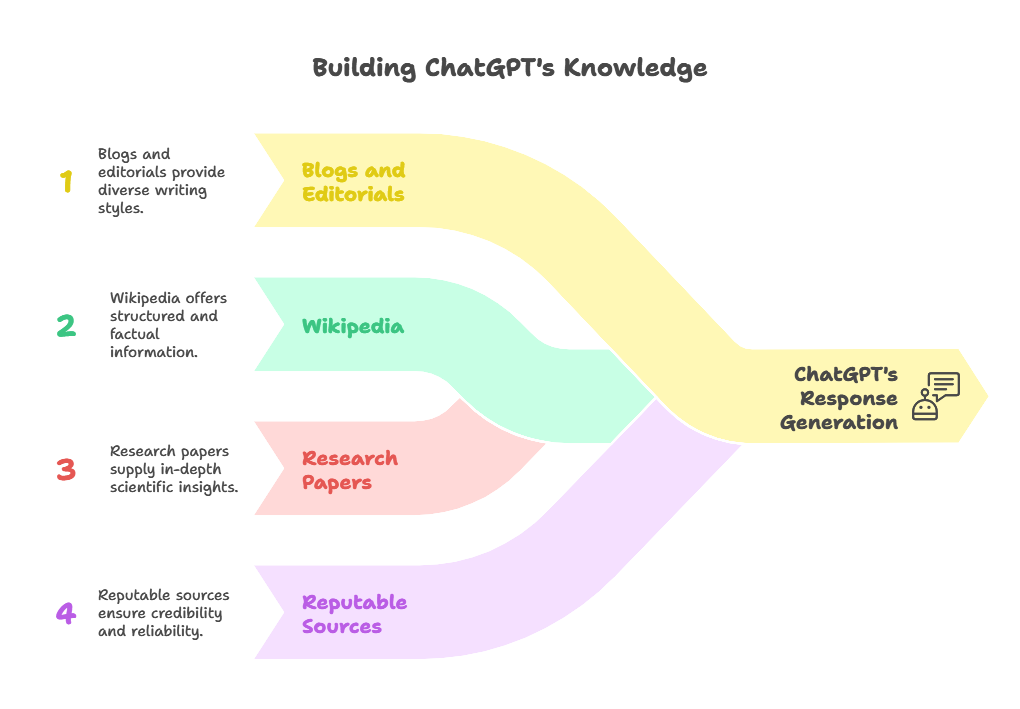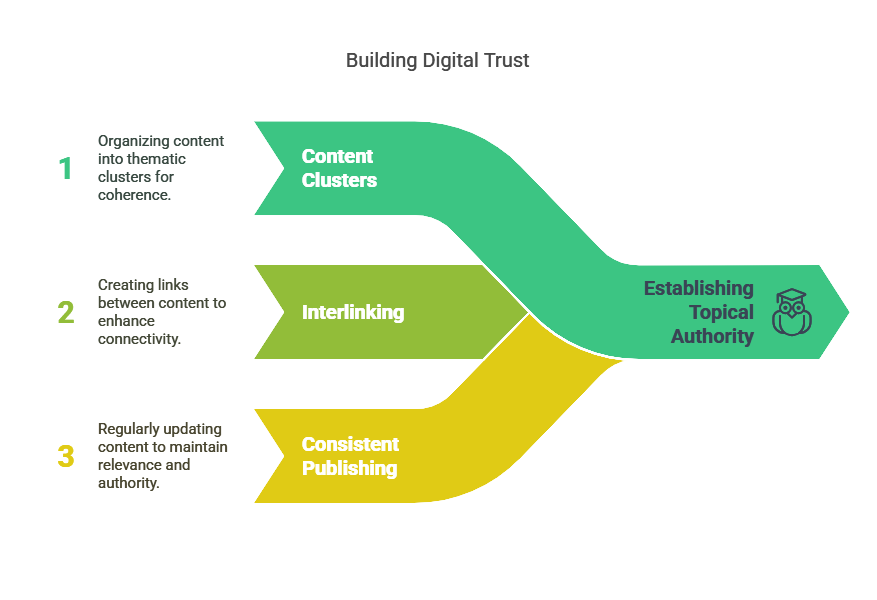Key Takeaways
ChatGPT has over 400 million weekly users and handles 1 billion+ daily queries. You miss visibility and business opportunities if your content doesn't appear there.
And no, traditional SEO isn't enough.
Unlike Google, ChatGPT doesn't rank pages or crawl the web live. It generates answers based on what it has learned and the signals it trusts. These may include:
- Brand mentions across the web
- Good, frequent reviews on trusted platforms
- Keyword relevancy between your content and common prompts
- Age of your brand or product
- Third-party recommendations on "best of" or list-style articles
- Authority, like backlinks, domain strength, and social proof
So, if you've been optimizing for search engines but ignoring these AI-friendly signals, that could be why ChatGPT keeps quoting your competitors instead.
This blog post will show you how to rank on ChatGPT by aligning with what it pays attention to. But first, let's look at how ChatGPT pulls content.
Understanding How ChatGPT Generates Responses

Before ranking on ChatGPT, you need to understand how it thinks.
ChatGPT doesn't crawl the web every time someone asks a question. Instead, it generates responses based on what it picked up during its training phase. That training included a wide range of publicly available content from trusted sources, such as:
- Blogs and editorial articles
- Wikipedia and online encyclopedias
- Research papers and technical documents
- Product reviews and FAQs
- Forums like Reddit and Stack Overflow
ChatGPT "remembers" the structure, tone, and factual depth of the content it has been trained on. When someone asks a question, ChatGPT doesn't look for new information. It generates a response based on the knowledge it has acquired recently.
The closer your content matches those trusted formats, the better your chance of being quoted.
What ChatGPT Tends to Lean On
This is the type of content ChatGPT prefers:
- Clear, well-written, and structured content
- Pages with internal links and semantic context
- Detailed, helpful answers, not just quick summaries
- Sources that have high domain trust and visibility
Limitations to Keep in Mind
Consider these limitations when optimizing content for AI:
- Knowledge cutoff: Most ChatGPT models have a knowledge cutoff date, typically around April 2023. Therefore, any information or developments after this date may not be included in its responses.
- No real-time updates: ChatGPT does not access live internet content unless a browsing tool is enabled (such as in the Pro version of ChatGPT with web access). This means that their responses may not reflect recent blog posts, news articles, or other up-to-date information.
Now that you know how ChatGPT thinks, let's explore how to rank on ChatGPT by creating easily referenced content.
Key Benefits of Ranking on ChatGPT
When you optimize for ChatGPT visibility, you're not just chasing another traffic source—you're tapping into a fundamentally different user experience that offers unique advantages for your brand.
Here's why ranking on ChatGPT matters beyond just traffic numbers:
- Ad-free experience for users: Unlike Google, where paid ads dominate the top results, ChatGPT presents information without sponsored content, at least for now. This creates a level playing field where quality content wins, not advertising budgets.
- Higher trust and perceived authority: When ChatGPT cites your content as an answer, it carries an implicit endorsement that builds immediate credibility. Users perceive AI-cited sources as more authoritative than typical search results.
- Conversational, context-aware search: ChatGPT remembers conversation history and builds on previous questions, allowing your content to be surfaced across a user's entire journey.
- Fast, direct answers: The platform delivers precise information without requiring users to click through multiple pages. When your content is structured to provide these direct answers, you become the go-to resource.
- Ethical data use: Unlike traditional search engines that track user behavior for ad targeting, ChatGPT offers a more privacy-focused experience. This aligns your brand with ethical data practices that increasingly matter to consumers.
- Early-mover advantage: With only 15% of businesses actively optimizing for AI visibility, there's a big opportunity to establish dominance before your competitors catch up.
B2B SaaS companies that appear in ChatGPT responses see way higher conversion rates from those visitors compared to traditional search traffic. This suggests that AI-referred visitors arrive with higher intent and trust.
You can read our analysis on the impact of AI Search here.
Optimize for AI-Friendliness, Not Just Google
If you're wondering how to rank your website on ChatGPT, start by rethinking how your content is structured and surfaced. Old-school SEO relies on stuffing keywords, chasing backlinks, and fixing tech stuff. That still plays a role, but if you want to show up in ChatGPT responses, you must write the best way AI understands.
Artificial intelligence is not impressed by how often you say "best B2B software" in your subheadings. It trains on content that's clear, trustworthy, and easy to pull answers from.
Here's what works:
#1: Keep Your Content Clean and Readable
Content that's hard to skim won't get pulled. If a human skimming your page can get the gist in 30 seconds, AI can, too.
Focus on:
- Short sentences and paragraphs
- Bold subheadings to break sections
- Bullet points for scannable lists
- No clickbait or filler content
#2: Use Schema Markup
Schema helps AI models understand what your page is about. It's like putting labels on everything. Here's how to implement it effectively:
Step-by-step schema implementation:
- Identify the most appropriate schema type for your content (Article, FAQPage, Product, etc.)
- Generate the schema code using a tool like Schema Markup Generator
- Test your schema with Google's Rich Results Test
- Add the schema to your page's HTML
Example schema code for a SaaS product page:
<script type="application/ld+json">
{
"@context": "https://schema.org",
"@type": "SoftwareApplication",
"name": "YourSaaS Product",
"applicationCategory": "BusinessApplication",
"url": "https://www.yoursaasproduct.com",
"identifier": {
"@type": "PropertyValue",
"propertyID": "SKU",
"value": "12345"
},
"offers": {
"@type": "Offer",
"price": "49.99",
"priceCurrency": "USD",
"url": "https://www.yoursaasproduct.com/pricing"
},
"aggregateRating": {
"@type": "AggregateRating",
"ratingValue": "4.8",
"ratingCount": "1250"
},
"description": "A comprehensive solution for [specific problem]."
}
</script>
For FAQ content, which performs exceptionally well in ChatGPT, use this structure:
<script type="application/ld+json">
{
"@context": "https://schema.org",
"@type": "FAQPage",
"mainEntity": [{
"@type": "Question",
"name": "How do I rank on ChatGPT?",
"acceptedAnswer": {
"@type": "Answer",
"text": "To rank on ChatGPT, focus on creating structured content with clear headings, use schema markup, build topical authority, and establish credibility through third-party mentions."
}
}, {
"@type": "Question",
"name": "What is schema markup?",
"acceptedAnswer": {
"@type": "Answer",
"text": "Schema markup is a code that you add to your website to help search engines better understand your content, improving your SEO."
}
}]
}
</script>
#3: Lean Into FAQs, Lists, and Definitions
Some formats appear in AI answers because they're simple to parse and easy to pull into a response. If you can turn a chunky paragraph into a crisp list or one-line explanation, do it.
Here are some examples:
- FAQs: These are ready-made ChatGPT snippets, which are perfect for surfacing as quick answers.
- Lists: Step-by-step guides, top-10-style breakdowns, and pros/cons lists are scannable.
- Definitions: Quick, dictionary-style explanations help ChatGPT give instant clarity to users.
One brand that nailed this approach is Viv, a sustainable period care company. Their blog is filled with clean, structured, question-led content that directly addresses what people ask ChatGPT. As a result, they've seen a 400% increase in blog traffic and a 436% boost in sales conversions, all driven by ChatGPT visibility.
Build Topical Authority Over Time

You can't publish one blog and expect AI to trust you. ChatGPT rewards depth, and building topical authority is key to learning how to rank on ChatGPT search.
Here's how to do that:
#1: Publish in Clusters
Start with a comprehensive pillar post on a core topic (like "AI SEO Strategies"), then build subpages around related queries:
- How to rank higher on ChatGPT
- AI SEO tools for 2025
- Best practices for Bing SEO
With these posts linked, you've created a topic cluster for SaaS that AI can easily follow.
#2: Interlink Everything
Connect your pillar pages with their related subpages and link back from the subpages to the pillar. Use descriptive anchor text so it's obvious what each link is about. This improves user navigation and helps search engines (and AI models) understand how your content is organized.
#3: Show Up Consistently
Publishing weekly or monthly on related topics builds a pattern. Over time, ChatGPT sees your site as a go-to resource for that subject.
#4: Get Cited in Third-Party Content
Being mentioned in industry roundups, "best of" lists, and guest posts boosts your chances of appearing in ChatGPT responses. These third-party citations act as trust signals that reinforce your authority.
How to get included in industry lists and roundups:
- Identify target publications: Look for sites in your industry that regularly publish listicles, roundups, or "expert opinion" pieces.
- Personalize your pitch: Research the editor or content manager and craft a personalized outreach email that explains why your perspective would be valuable to their audience.
- Offer unique insights: Don't just ask to be included—provide a unique angle or data point that makes your contribution valuable.
Make Your Content Easy for ChatGPT to Read

This is where formatting matters. You could have the best answer on the internet, but it won't get picked if it's buried in dense paragraphs. The key is to format your content like you're writing for a busy reader with zero patience.
Let's look at how to improve readability.
Use the "Answer-First" Format
Think like a journalist. Lead with the answer, then explain the why or how. AI loves the inverted pyramid structure, where the main point is at the top, followed by the supporting details.
Instead of: "Many companies use cloud storage for various reasons."
Try: "Cloud storage reduces costs, improves scalability, and makes access easier for remote teams."
Answer Questions Directly
Structure your content like it's answering a user prompt. Put yourself in the reader's shoes. What would they ask ChatGPT?
- How do I rank on ChatGPT?
- Is ChatGPT using Google to find results?
- Does schema markup help with AI SEO?
Match your headings to fundamental questions, and write your answers like ChatGPT would. That's exactly what ChatGPT is trained to recognize.
Use Visual Cues to Guide Attention
Highlight key takeaways with bold text, callout boxes, or icons. These visual cues help readers (and AI) quickly spot the most essential information without reading every word.
Think of them as signposts that say, "This part matters."
Create Prompt-Style Headlines
People often search with full questions like "What's the best CRM for startups?" To make your content more discoverable by AI, frame your headlines as questions that match users' queries.
Step-by-step process for creating prompt-style headlines:
- Identify the search query (e.g., "project management software")
- Transform it into a question a real person would ask (e.g., "What is the best project management software?")
- Add specificity for your target audience (e.g., "What is the best project management software for remote marketing teams?")
- Include timely elements if relevant (e.g., "What is the best project management software for remote marketing teams in 2025?")
AI tools prefer content that directly answers questions, so using question-style headlines can improve your chances of being picked.
When your content follows these formatting principles, ChatGPT can easily extract the relevant information and present it to users, increasing your chances of being cited as a source.
Establish Credibility and Domain Trust

AI models are trained to favor content that comes from sources people trust. It will not get picked if your site looks sketchy, spammy, or anonymous.
#1: Get High-Authority Backlinks
Links from trusted sites act like votes of confidence. The top result on Google usually has 3.8x more backlinks than pages ranked below it, which also matters to AI tools.
Make backlink-building part of your strategy by:
- Pitching guest posts to relevant, trustworthy blogs
- Getting featured in industry roundups or media
- Publishing original research
#2: Use Real Authors and Bios
People trust people, not anonymous content. Include:
- Real author names
- Bios with relevant experience or expertise
- Credentials, roles, or achievements, especially if you're in a technical or niche field
- Author headshots
- Social links, if relevant
#3: Clean Up Your Site Design
Busy, cluttered sites can look low-quality to AI. A clean layout with simple navigation makes it easier for ChatGPT to understand and trust your content.
Here's how:
- Limit ads or pop-ups
- Avoid spammy CTAs or autoplay videos
- Use a mobile-friendly design and fast-loading pages
#4: Leverage Additional Trust Signals
To further establish credibility, consider these additional strategies:
Industry Awards and Recognition
- Apply for relevant industry awards
- Display badges and certificates prominently
- Create dedicated "Awards & Recognition" content that explains the significance
Influencer Collaborations
- Partner with respected industry experts for co-created content
- Feature expert quotes and insights in your articles
- Host webinars or podcasts with recognized authorities
Positive Reviews and Testimonials
- Actively solicit reviews on platforms like G2, Capterra, and Trustpilot
- Respond thoughtfully to all reviews, especially negative ones
- Implement structured review schema on your site
Affiliate Listicles and Roundups
- Develop relationships with sites that create "best of" lists in your industry
- Offer unique affiliate arrangements to incentivize inclusion
- Provide comprehensive product information to make listing your product easy
Get Listed on Trusted Data Sources

ChatGPT learns from public, high-authority platforms. If your company isn't showing up on those platforms, you're missing an easy win.
Here's how to get on its radar:
#1: Get Listed Where It Matters
Make sure your brand has a presence on platforms that ChatGPT recognizes and pulls from:
- Wikipedia: Great for brand, product, or founder bios
- Crunchbase: Especially important for SaaS companies and startups
- GitHub: If you offer tools, integrations, or open-source support
- LinkedIn: A strong company and founder profile reinforces authority
#2: Participate in Community Platforms
These are gold mines for training data and influence:
- Reddit & Quora: Answer real user questions and build topical authority
- Product Hunt: Launch tools, gather feedback, and gain early traction
- Stack Overflow: Ideal for technical brands and developer-facing products
#3: Don't Ignore Review Sites
When users ask ChatGPT to "compare tools" or "recommend software," review platforms often shape the response:
- G2
- Capterra
- Trustpilot
- Gartner
Encourage satisfied users to leave honest reviews—these can directly influence how AI represents your product.
Use Prompt-Based SEO Thinking
While keyword research is helpful, prompts are more powerful. ChatGPT replies to specific, often long-tail questions.
People usually type full questions into AI tools. Your content should be shaped around those.
#1: Turn Search Terms Into Questions
Instead of using the "project management tool," try "What's the best project management tool for remote teams?" Understanding user prompts is key to ranking on ChatGPT search, especially for long-tail, question-driven content.
#2: Focus on Intent
People aren't looking for a mere list of features. They want help figuring out which option is right for them. Try including:
- Comparison posts
- Pros and cons
- How-to guides
- "Best of" roundups by use case or industry
#3: Use Prompt-Style Headlines
People often search with full questions like "What's the best CRM for startups?" To make your content more discoverable by AI, frame your headlines as questions that match users' answers.
AI tools prefer content that directly answers questions, so using question-style headlines can improve your chances of being picked.
Example:
Instead of: "Top CRM for Startups"
Try: "What's the Best CRM for Startups in 2025?"
This makes it easier for AI to match your content with user queries.
#4: Implement the llms.txt Protocol
The llms.txt protocol is an emerging standard that allows website owners to specify how AI models should interact with their content. By implementing this file, you can provide explicit permission and guidelines for AI systems to reference your content.
Technical checklist for AI crawler access:
- [ ] Update robots.txt to allow AI crawlers
- [ ] Create and implement an llms.txt file in your root directory
- [ ] Verify crawler access with server logs
- [ ] Ensure your sitemap.xml is up to date
- [ ] Check that important pages aren't blocked by login walls or cookie consent overlays
- [ ] Monitor AI crawler activity in your analytics
By ensuring AI systems can properly access and understand your content, you significantly increase the chances of being referenced in ChatGPT responses.
#5: Reverse Engineer User Intent
- Identify your target keyword (e.g., "enterprise email marketing software")
- Ask ChatGPT what questions users have about this topic
- Group the questions by intent (awareness, consideration, decision)
- Create content that addresses each intent stage
Here's a sample framework for building content around a "best tools" query:
By structuring your content to answer the what, why, and how of user queries, you create comprehensive resources that ChatGPT is more likely to reference when responding to related prompts.
Update and Train Your Content Frequently

Old content might still be technically correct, but ChatGPT prefers fresh content. AI tools prioritize content that's recent, relevant, and getting attention. If your blog post hasn't been touched since 2021, it's probably not doing you any favors.
#1: Refresh Old Content Regularly
Audit your content quarterly and refresh top-performing articles with the following:
- Add new stats or studies
- Update tool lists with pricing and screenshots
- Fix broken links and revise old examples
- Include the current year in post titles
#2: Use SEO Tools to Stay Ahead
Tools like SurferSEO, Frase, or Clearscope can help you spot content gaps. They give you a competitive edge by analyzing what's ranking now and where your content might fall behind. They help:
- Identify keywords you're missing
- Compare your structure with competitors
- Improve on-page SEO and readability
#3: Improve Page Load Speed
Page load speed is a crucial ranking factor. Slow pages can harm both your SEO and user experience. To improve speed:
- Compress images without losing quality
- Minimize JavaScript and CSS files
- Use a content delivery network (CDN) to deliver content faster globally
Test How Your Site Shows Up in AI Tools
Testing how your site shows up can give you valuable insights into what's working and what needs tweaking. Let's explore how you can use these tools to check and improve your site's visibility.
Track Referral Traffic
Use Google Analytics 4 to see if tools like ChatGPT or Perplexity send traffic to your site.
Here's how:
- Go to Reports → Traffic acquisition
- Set the dimension to Session source/medium
- Look for sources like chat.openai.com, perplexity.ai, or you.com
If you spot traffic from these sources, AI tools cite or click your content.
Test Your Visibility
Use popular AI tools to simulate real user prompts:
- ChatGPT: Type in questions your audience might ask
- Perplexity.ai: See what sources it cites in responses
- You.com: Try intent-driven searches like comparisons or product roundups
- Bing Chat: ChecK responses tied to live search results
Look for:
- Who's getting quoted?
- What kind of pages are shown?
- How are answers structured? Do they include lists, summaries, and definitions?
This helps you spot what AI tools favor and what your content may be missing.
Common Pitfalls and Disadvantages of ChatGPT
While optimizing for ChatGPT offers amazing opportunities, it's important to understand the limitations and potential drawbacks of relying too heavily on this channel.
Knowledge Limitations
- Outdated information: ChatGPT's training data has a cutoff date, meaning it may cite your content but miss your most recent updates or product changes. This can lead to misrepresentation of your current offerings.
- Hallucinated (incorrect) citations: ChatGPT occasionally "hallucinates" information, citing sources that don't exist or attributing statements to your brand that you never made. This poses reputation risks if not monitored.
- Real-time data: ChatGPT (without browsing capabilities) is not as good as Google in accessing breaking news, recent product launches, or timely content published after its training cutoff.
User Experience Challenges
- Literal, sometimes incomplete responses: ChatGPT tends to provide literal answers to questions without the nuance, emotion, or brand personality that your marketing content carefully cultivates.
- No human touch or nuance: The AI may miss subtle positioning elements, tone differences, or emotional appeals that differentiate your brand from competitors.
- Inconsistent attribution: Sometimes ChatGPT will mention your brand without linking to your site, or reference your content without proper attribution.
Strategic Considerations
- Cannibalization of direct site visits: When ChatGPT answers questions comprehensively using your content, users get what they need without ever visiting your website, potentially reducing your ability to capture leads.
- Competitor comparison risk: In competitive queries, ChatGPT often presents multiple options side-by-side, potentially positioning your product alongside competitors you'd rather not be compared with directly.
- Limited control over presentation: Unlike your website or paid media, you have minimal control over how ChatGPT presents your information or what aspects it emphasizes.
How to mitigate these risks:
- Implement a regular monitoring system for how your brand appears in ChatGPT responses
- Create content that explicitly encourages users to visit your site for additional resources
- Use ChatGPT plugins or API integrations to provide more direct, controlled experiences
- Balance your AI visibility strategy with traditional traffic-driving tactics
Remember, ChatGPT optimization should complement—not replace—your broader digital marketing strategy. The most effective approach integrates AI visibility with traditional SEO, content marketing, and conversion optimization.
Create Content That Gets Quoted by ChatGPT
If you want to rank on ChatGPT, the formula is simple: be clear, helpful, and well-structured.
You don't need hundreds of blog posts. What matters is creating a few in-depth pieces that stay fresh and establish your brand as a trusted reference. Start with quality, then keep testing and improving. Position your content to be precisely what AI tools like ChatGPT want to highlight.
And that is what TripleDart, an AI SEO agency, does for clients. We help build content that ranks, gets quoted, trusted, and clicked.
Mastering how to rank on ChatGPT can drive real business impact. Book a call with TripleDart to learn how we can help.
FAQs
How to rank in SearchGPT?
Write explicit, structured content that answers fundamental questions. Use formats like lists, FAQs, and definitions to get mentioned on trusted sites.
How to SEO for ChatGPT?
Focus on clean formatting, topical depth, and helpful content. To stay relevant, use schema markup, write answer-first, and refresh posts regularly.
How do I show up in ChatGPT results?
Use question-based headings, provide direct answers, and get cited on high-authority sites like Reddit, Quora, or Wikipedia.
How to be indexed in ChatGPT?
Publish on platforms AI trains on, like Crunchbase and GitHub. Build backlinks, structure your content well, and keep it current.
Related Posts
We'd Love to Work with You!
Join 70+ successful B2B SaaS companies on the path to achieving T2D3 with our SaaS marketing services.

.png)
.png)






.webp)
